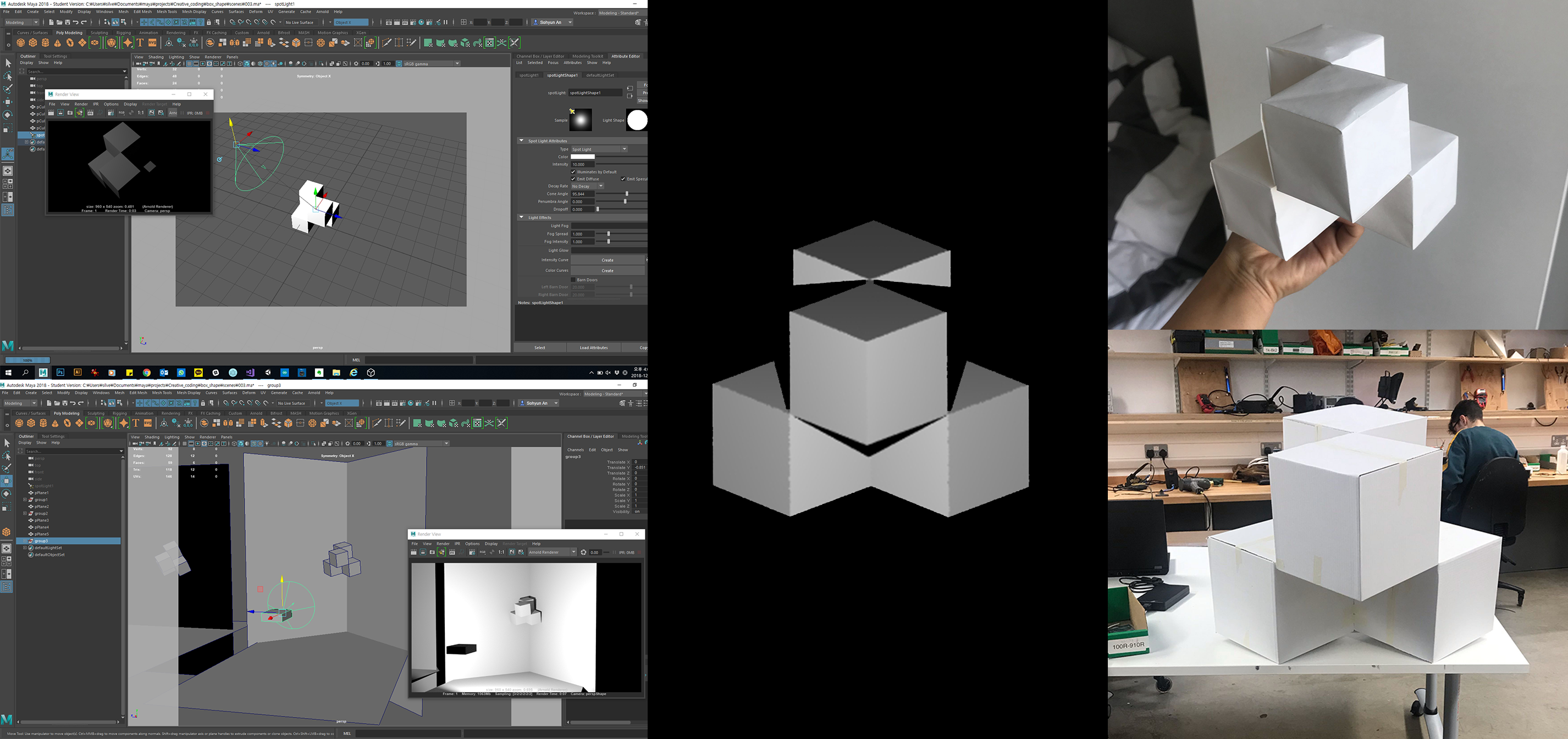The Three Powers
According to Asian philosophy, the universe consists of the three powers; Heaven, Earth and Man. This projection mapping project expresses the concept of each power in three different scenes.
produced by: Sohyun An
Introduction
Throughout the world, “3” was considered as a sacred number from ancient times. Especially, the three powers(三才/삼재) – Heaven, Earth and Man (天地人/천지인) – were believed the foundation of the world in East-Asian philosophy. This project expresses the concept of the whole universe embracing the three powers’ themes, on a unique shape which is made up of 4 cubes.
Concept and background research
First, I chose the themes for each scene as heaven(sky), earth(ground) and man, and then picked one or two materials expressing each theme. Finally, I matched their theme colours as blue, green and red, which are the primary colours of light.
1. Sky
The first scene is Sky – or Heaven. In the belief of the three powers philosophy, this is not only the simple meaning of the sky but also containing the meaning of the laws and the circulation of nature. Among various materials which can show this theme of Sky, I chose an image of cloud-rain circulation. Blue was matched for it in the three primary colours. In the first design, 2 surfaces on the top were also considered for this circulation theme but replaced by a starry sky theme, because it was quite unnatural in the projection simulation on screen.
2. Ground
The second scene is Ground or Earth, which means physical and interactive environment all around the Earth. For describing this, I chose a house motif including door, windows and walls. Green was matched for this theme’s colour.
3. Human
The last scene is Human, including all spiritual values such as minds, spirits, emotions or souls. With motifs of human’s heartbeat and Vitruvian Man the famous drawing of Leonardo Da Vinci on a dynamic colour background, I tried to illustrate a human being who has infinite potentials. Red was matched for it.
Technical
This project used OpenFrameworks(C++) with several add-ons, including the ofxPiMapper to project it on physical shape, using a projector. For the first scene of Sky, I used vectors and arrays, with ofNoise for natural random shapes, making particles of all shapes of water - vapour, raindrops, clouds and water. In the second scene about Ground and human walking was composed of a lot of hard-coding parts based on frame numbers for timing between doors and the human character’s movement. However, for easy drawing each object – human, window and doors, I had to use my custom functions. And finally, I studied various ways of colour controls for the third scene to make the heartbeat-like line shape and the background.
Building our group’s unique shape “cubeyw00beys”, we simulated in a virtual method as well as physical methods. For the best projecting direction and display structure, we made a virtual simulation in Maya and a physical model in both the real scale/miniature scale. Despite the weakness that it is not possible to project all surfaces of this shape with one projector, we could build a great shape for the exhibition as a result of trial and error in many tests.
Future development
My human character, a simple stickman can do simple walking and movement, but it would be better if it could show storytelling or interactions so that it can integrate all scenes in one big theme. For this, the character drawing function also should be modularized and polished more. This project draws all the shape including the human by ofGraphics functions to minimize external sources, but if I do in-depth work for this, it is also worth considering to use suitable animations or images for drawing it.
Self evaluation
Overall, I am happy with my work. It was my first projection mapping, so I did a lot of trial and error. My coding was also never perfect, but rather dirty rags. However, designing screens or surfaces by myself and coding them by myself from the start to the end was a great experience as a beginner coder, which was also a good opportunity to understand about the 2D onscreen and the 3D real world.
Good things
1. I was not good at making abstract arts, so I designed my work as concrete concepts as possible. Therefore I could not find good examples or references for my design work, but at the same time, it made my work so unique.
2. Projecting images on each different combination of surfaces, it successfully expressed various silhouettes in one shape. Our shape had a weakness that some sides are fragmented by shadows, however, all of our group members (including I) not only overcame this problem but also developed this limitation to a good design element.
Desired things
1. It was not easy to design and code the character’s movement. In the end, I failed to make an animation for the first scene, and this problem lessened the unity of the whole project.
2. After setting all members’ project in one laptop, the speed drop problem occurred. We could not find the reason for it so failed to fix it to the last. My second scene was made strongly depended on frame numbers, so it got the most severe damage. I modified the json file as a temporary measure, but it was not enough to show the original. As a result, I failed to display my original plan and design.
References
1. Lab examples
Week 5 : organic typography by Theo Papatheodorou
Week 5 : noisy sun by Theo Papatheodorou
Week 5 : harlem shake by Theo Papatheodorou
2. Inspiration
Vitruvian Man by Leonardo da Vinci : https://en.wikipedia.org/wiki/Vitruvian_Man

































































